
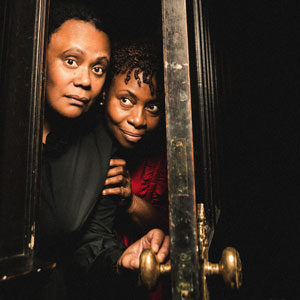 [rating=4]Eighty-three years from when it was first produced, the classic “Arsenic and Old Lace” still keeps us laughing. The spectacle of two maiden aunts (i.e., two old fussbudgets) killing off middle-aged and elderly men is as clever now as it was back in the day. Based on a beautifully written script by Joseph Otto Kesselring and directed by resident artist Ron OJ Parson, this combination dark comedy and macabre farce features characters whose motives are dubious and whose actions are outright reprehensible and immoral.
[rating=4]Eighty-three years from when it was first produced, the classic “Arsenic and Old Lace” still keeps us laughing. The spectacle of two maiden aunts (i.e., two old fussbudgets) killing off middle-aged and elderly men is as clever now as it was back in the day. Based on a beautifully written script by Joseph Otto Kesselring and directed by resident artist Ron OJ Parson, this combination dark comedy and macabre farce features characters whose motives are dubious and whose actions are outright reprehensible and immoral.
Two sisters Abby Brewster (Taylar) and Martha Brewster (Celeste Williams) deliberately poison a number of men whom they deem to be lonely, in the misbegotten belief that facilitating their demise is a “mission of mercy.” No one could possibly suspect the aunts of having committed such terrible crimes—no less murder—considering that they are respectable citizens, loved by their church, their minister, and their local police department. But in the Brewster family, this tendency to kill and bury people (and to justify it, no less!) runs in the genes, dating from past generations and on through the present. It apparently affects their nephews Teddy (Alan D. Edge) and Jonathan (A.C. Smith) as well. Teddy honestly believes that he is the former President Theodore Roosevelt: Not only does he look the part, but he says “Bully” all the time, plays his trumpet loudly, bangs his riding crop, and believes that the Panama Canal is actually in the basement of their elegant Brooklyn house. His aunts do not disavow him of that notion, because this is where he provides a “proper burial” to all the deceased men who—his aunts tell him—have died of yellow fever. Jonathan (who is intentionally made up to look like Boris Karloff) and his accomplice, the plastic surgeon Dr. Henry Einstein (Guy Van Swearingen), make their appearance with their own decedent in tow, whom they also want to bury in the basement. The only one seemingly not affected by the “family tendency” is the third nephew Mortimer (Eric Gerard), who initially finds the behavior of his entire family erratic and eccentric, but only later realizes just how spiritually and morally bankrupt they truly are.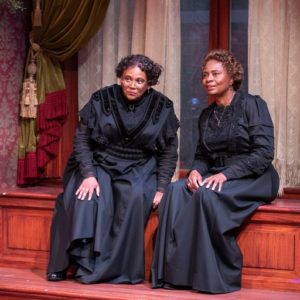
We see the play largely through Mortimer’s eyes. He is generally oblivious to what is happening around him, that is, until he is just about to marry his fiancé Elaine Harper (Emma Jo Boyden) and starts making excuses about his family members to her. A theatre reviewer by profession, Mortimer generally sees things around him through the lens of a critic, that is, at some distance from the action on stage. He asks himself, “Does this make a good story?” “Why is it that the main character does not suspect X, Y, or Z as being the criminal?” As a result, he fails to comprehend the enormity of his family’s madness until it hits him hard like a ton of bricks—or like a drapery cord strung around his neck. Only then does he come to understand the magnitude of his brother Jonathan’s criminal tendencies. It is interesting to watch how the various police officers (played by Norm Boucher, Thomas J. Cox, Allen Gilmore, and Matthew Lunt) want to enforce the laws (although do so lackadaisically), whereas the Brewster family (with the exception of Mortimer) simply don’t want to follow the law and make up their own set of standards. Yet all of the characters understand moral convention, such that everybody is always hiding something that they suspect might get them into trouble. The only exception are the two aunts, who freely admit to Mortimer that they have killed and will continue to do so.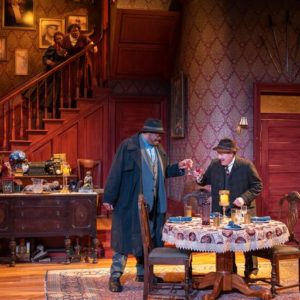
The show is worth attending just to see the gorgeous multilevel set design by John Culbert. (It was so interesting listening to other members of the audience ooh and aah about the beauty of the set even before the show began.) The set features authentic hardwood floors; wooden casements for all the doors and windows, plus an ample window seat; antique furniture, lamps, and rugs in great condition; and old-fashioned black and white photographs that line the wall along the wooden staircase, which features a lovely balustrade. The glow of the pink and light green/grayish art deco wallpaper combined with the superior lighting by Jared Gooding makes the illusion of an old-fashioned Brooklyn house come alive—and we perceive of it as a happier place than we would otherwise imagine, considering all the bodies buried in the basement. Note that popular songs roughly from the late 1930s/early 1940s (and beyond) play as the audience assembles for the performance. Period costumes by Rachel Anne Healey are constructed very nicely; the patterns and fabrics are more than appropriate. Wigs and makeup are due to the fine efforts of Rebecca A. Scott Designs.
If you’ve only seen the movie before and never the play that preceded it, then you ought to see this production. This script holds up nicely after all these years, because of the audience’s general knowledge of the references to Theodore Roosevelt, Boris Karloff, and Albert Einstein, and due to its emphasis on physical comedy and situational humor which transcend time and place. The fact that the Brewster family is African-American in this show is intentional: It is meant to point up that black families did live in Brooklyn during this time period and that all families (of whatever race, religion, ethnicity, or color) may have members who exhibit unusual personality traits as well as hold fast to family secrets that outsiders are rarely privy to.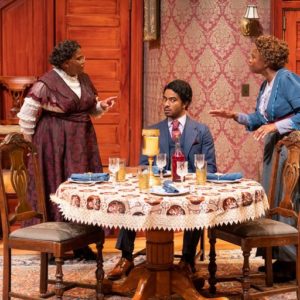
Ironically, the Brewster family’s secret is ultimately more tragic than it is comedic. Taking an actual but gruesome true crime story about a “lady murderer” and turning into a successful farce is ultimately a credit to Kesselring’s fine writing. It’s amazing that the tale still resonates well in an era when there has been so much senseless crime, violence, and mass murder every day in the news, not to mention our modern sensitivities when it comes to issues surrounding mental illness. In the last analysis, watching the various characters stumble, bumble, and dance around those realities is what makes this play so funny. The body language and energy that the characters exude confuse good, evil, and horror pleasantly: a circumstance that surprisingly charms the audience. Not only do we enjoy a good laugh, but we like to be bemused for the moment until our moral compass kicks in.
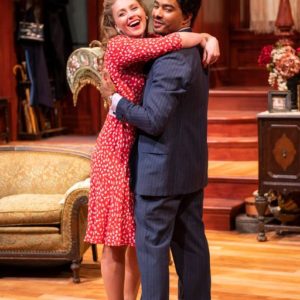 “Arsenic and Old Lace” is playing at Court Theatre, 5535 S. Ellis Avenue, in Chicago, on The University of Chicago Campus, through October 2, 2022. FREE parking in the adjacent garage
“Arsenic and Old Lace” is playing at Court Theatre, 5535 S. Ellis Avenue, in Chicago, on The University of Chicago Campus, through October 2, 2022. FREE parking in the adjacent garage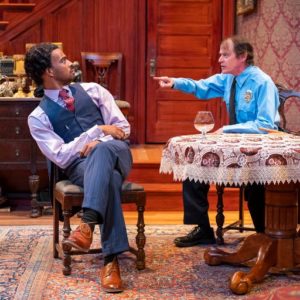
Tickets are at $23.50-$85.50, depending on date and seat location. Price includes per ticket fees.
Performance schedule:
Wednesdays 7:30 p.m.,
Thursdays 7:30 p.m.
Fridays – 7:30 p.m.
Saturdays and Sundays – 2:00 p.m. and 7:30 p.m.
For more information about the show and to purchase tickets, go to: https://tickets.courttheatre.org/Online/default.asp or call the box office at (773) 753-4472.
If you have any accessibility needs, please contact the box office at (773) 753-4472 so that they can best assist you.
For general information about Court Theatre and their other offerings, visit: Home (courttheatre.org).
COVID-19 requirements are still in effect. You will be asked to wear your mask throughout the entire performance unless you are actively eating or drinking. This can be subject to change at any time. Please check their website for more details.
To see what others are saying, visit www.theatreinchicago.com, go to Review Round-Up and click at “Arsenic and Old Lace”.






More Stories
“Survivors” reviewed by Julia W. Rath
“Prayer for the French Republic” reviewed by Julia W. Rath ( and another by Paul Lisnek)
“Obliteration” reviewed by Mark Reinecke